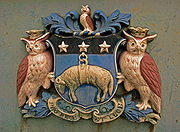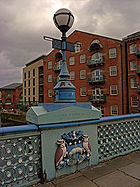
Leeds Bridge
Encyclopedia



Leeds
Leeds is a city and metropolitan borough in West Yorkshire, England. In 2001 Leeds' main urban subdivision had a population of 443,247, while the entire city has a population of 798,800 , making it the 30th-most populous city in the European Union.Leeds is the cultural, financial and commercial...
, England. The present cast iron road bridge dates from 1730. It is Grade II listed.
The medieval town of Leeds centred on 13th century burgess building plots either side of a wide road from the river crossing called Bridge Gate, now Briggate. A wool cloth market operated at Leeds Bridge, becoming the centre of wool trade for the West Riding of Yorkshire
West Riding of Yorkshire
The West Riding of Yorkshire is one of the three historic subdivisions of Yorkshire, England. From 1889 to 1974 the administrative county, County of York, West Riding , was based closely on the historic boundaries...
in the late 17th century.
A medieval bridge was built at the site of a ferry across the River Aire
River Aire
The River Aire is a major river in Yorkshire, England of length . Part of the river is canalised, and is known as the Aire and Calder Navigation....
. It was widened in 1730 and 1760. The bridge was rebuilt in 1870-73 by W. H. Barlow
William Henry Barlow
On 28 December 1879, the central section of the North British Railway's bridge across the River Tay near Dundee collapsed in the Tay Bridge disaster as an express train crossed it in a heavy storm. All 75 passengers and crew on the train were killed...
to a design by T. Dyne Steel. The iron was cast by John Butler of Stanningley
Stanningley
Stanningley is a district of Pudsey, West Yorkshire, England. It is situated approximately west of Leeds city centre on the original main road from Leeds to Bradford...
. The cast iron balustrade
Baluster
A baluster is a moulded shaft, square or of lathe-turned form, one of various forms of spindle in woodwork, made of stone or wood and sometimes of metal, standing on a unifying footing, and supporting the coping of a parapet or the handrail of a staircase. Multiplied in this way, they form a...
is of rings and flowers. The east side bears the arms of the Corporation of Leeds (crowned owls and fleece). The western side has the names of civic dignitaries on a plaque.
Leeds Bridge marks the western terminus of the Aire and Calder Navigation
Aire and Calder Navigation
The Aire and Calder Navigation is a river and canal system of the River Aire and the River Calder in the metropolitan county of West Yorkshire, England. The first improvements to the rivers above Knottingley were completed in 1704 when the Aire was made navigable to Leeds and the Calder to...
which opened in 1700 creating a vital goods transportation infrastructure.
Pioneering moving image
In 1888 Louis Le PrinceLouis Le Prince
Louis Aimé Augustin Le Prince was an inventor who is considered by many film historians as the true father of motion pictures, who shot the first moving pictures on paper film using a single lens camera....
made a pioneering moving picture recording of traffic on Leeds Bridge from an upstairs window of No 19 Bridge End, then Hicks the Ironmongers.
See also
- Louis Le Prince - Leeds Bridge for the pioneering moving picture film Traffic Crossing Leeds Bridge by Louis Le Prince

